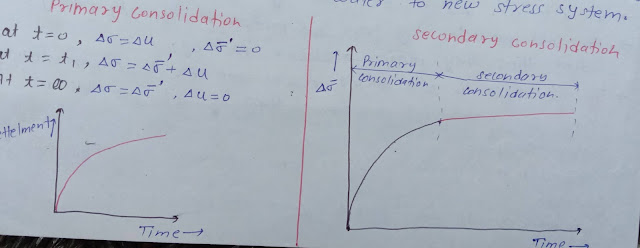What is consolidation? , Primary consolidation, secondary consolidation
Consolidation:-
The the compression of a saturated soil under static pressure is known as consolidation.
It is occurs due to expulsion of water from the voids.
The the soil particles shift from one position to other by rolling and sliding thus they attain a closer packing.
The decrease in soil volume occurs not due to compression of solids or water but due to shifting of soil particles as water escapes.
Consolidation can occurs due to one or more of the following factors.
1. Due to external static loads from the structure.
2. Due to self weight of soil such as recently placed fills.
3. Due to lowering of the ground water table.
4. Due to desiccation.
Primary consolidation:-
After initial consolidation further reduction in volume occurs due to the expulsion of water from the voids.
When saturated soil is subjected to a load or pressure initially all the pressure is taken up by water as an excess pore water pressure.
As water is almost incompressible as compared with soil solid particles a hydraulic gradient develops and water start flowing out and decrease in volume occurs.
The decrease depends upon the permeability of soil and is therefore time-dependent.
This reduction in volume is called primary consolidation.
Secondary consolidation:-
The reduction in volume continues at a very slow rate even after the excess hydrostatic pressure developed by the applied pressure is fully dissipated primary consolidation is complete.
The additional reduction in volume is called secondary consolidation.
It is attributed to the plastic readjustment of the solids particles and the the adsorbed water to new stress system.
 |
| Primary and secondary consolidation |

Comments
Post a Comment